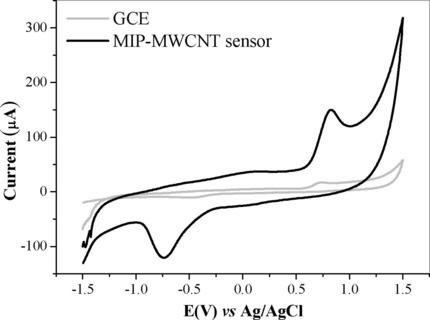当前位置:
X-MOL 学术
›
Electroanalysis
›
论文详情
Our official English website, www.x-mol.net, welcomes your
feedback! (Note: you will need to create a separate account there.)
Development of a Molecularly Imprinted Poly(Acrylic Acid)‐MWCNT Nanocomposite Electrochemical Sensor for Tramadol Determination in Pharmaceutical Samples
Electroanalysis ( IF 2.7 ) Pub Date : 2020-01-30 , DOI: 10.1002/elan.201900148 César Ricardo Teixeira Tarley 1, 2 , Jhessica Cássia Mendonça 1 , Luana Rianne da Rocha 1 , Tainara Boareto Capelari 1 , Maiyara Carolyne Prete 1 , Matheus Cecílio Fonseca 3 , Fernanda Midori de Oliveira 1 , Arnaldo César Pereira 3 , Guilherme Luiz Scheel 1 , Keyller Bastos Borges 3 , Mariana Gava Segatelli 1
Electroanalysis ( IF 2.7 ) Pub Date : 2020-01-30 , DOI: 10.1002/elan.201900148 César Ricardo Teixeira Tarley 1, 2 , Jhessica Cássia Mendonça 1 , Luana Rianne da Rocha 1 , Tainara Boareto Capelari 1 , Maiyara Carolyne Prete 1 , Matheus Cecílio Fonseca 3 , Fernanda Midori de Oliveira 1 , Arnaldo César Pereira 3 , Guilherme Luiz Scheel 1 , Keyller Bastos Borges 3 , Mariana Gava Segatelli 1
Affiliation

|
A new voltammetric sensor based on molecularly imprinted poly(acrylic acid)‐MWCNT nanocomposite (MIP‐MWCNT) drop‐coated onto glassy carbon electrode (GCE) was developed and applied to tramadol (TR) determination in pharmaceutical samples. The voltammetric sensor prepared by suspension of MIP‐MWCNT at 1 : 1 (w/w) ratio show an improved performance compared to unmodified GCE. The electrochemical method is based on preconcentration of tramadol onto MIP‐MWCNT modified GCE surface at −1.5 V vs Ag/AgCl for 180 s in 0.1 Britton‐Robinson buffer (pH 8.0) at stirred solution. Upon preconcentration, the differential anodic voltammogram was recorded under the optimized condition giving rise to an analytical curve varying from 9.0 up to 30.0 μmol L−1 (R2=0.997) and limits of detection and quantification of 1.4 and 4.8 μmol L−1, respectively. The method precision was assessed in terms of intraday (n=6) and interday (two consecutive days) precision, giving relative standard deviations (RSD%) values between 2.8 to 7.4 %. Excipients usually found in pharmaceutical pills (magnesium stearate, microcrystalline cellulose, starch, and silica) and paracetamol were evaluated as potential interferents, however no interference was evidenced in TR determination. The method applicability was evaluated by TR analysis in pharmaceutical samples. Moreover, the method accuracy was attested by comparison of addition and recovery assays with a reference technique (high‐performance liquid chromatography).
中文翻译:

用于药物样品中曲马多测定的分子印迹聚(丙烯酸)-MWCNT纳米复合电化学传感器的开发
基于分子印迹聚(丙烯酸)-MWCNT纳米复合材料(MIP-MWCNT)滴涂到玻璃碳电极(GCE)上的新型伏安传感器已开发并应用于药物样品中的曲马多(TR)测定。与未经修饰的GCE相比,通过以1:1(w / w)比例悬浮MIP-MWCNT制备的伏安传感器显示出改进的性能。电化学方法基于曲马多在0.1 Britton-Robinson缓冲液(pH 8.0)中于-1.5 V相对于Ag / AgCl的条件下预浓缩到MIP-MWCNT修饰的GCE表面上180 s,搅拌时间为1.5 s。在预浓缩后,在最佳条件下记录微分阳极伏安图,从而产生从9.0到30.0μmolL -1(R 2= 0.997)以及分别为1.4和4.8μmolL -1的检测和定量极限。根据日内(n = 6)和日间(连续两天)精度评估方法精度,得出的相对标准偏差(RSD%)值在2.8%至7.4%之间。通常将药用药丸中的赋形剂(硬脂酸镁,微晶纤维素,淀粉和二氧化硅)和对乙酰氨基酚评估为潜在的干扰物,但是在TR测定中没有发现干扰物。该方法的适用性通过TR分析在药物样品中进行了评估。此外,通过将添加和回收分析与参考技术(高效液相色谱)进行比较,证明了方法的准确性。
更新日期:2020-01-30
中文翻译:

用于药物样品中曲马多测定的分子印迹聚(丙烯酸)-MWCNT纳米复合电化学传感器的开发
基于分子印迹聚(丙烯酸)-MWCNT纳米复合材料(MIP-MWCNT)滴涂到玻璃碳电极(GCE)上的新型伏安传感器已开发并应用于药物样品中的曲马多(TR)测定。与未经修饰的GCE相比,通过以1:1(w / w)比例悬浮MIP-MWCNT制备的伏安传感器显示出改进的性能。电化学方法基于曲马多在0.1 Britton-Robinson缓冲液(pH 8.0)中于-1.5 V相对于Ag / AgCl的条件下预浓缩到MIP-MWCNT修饰的GCE表面上180 s,搅拌时间为1.5 s。在预浓缩后,在最佳条件下记录微分阳极伏安图,从而产生从9.0到30.0μmolL -1(R 2= 0.997)以及分别为1.4和4.8μmolL -1的检测和定量极限。根据日内(n = 6)和日间(连续两天)精度评估方法精度,得出的相对标准偏差(RSD%)值在2.8%至7.4%之间。通常将药用药丸中的赋形剂(硬脂酸镁,微晶纤维素,淀粉和二氧化硅)和对乙酰氨基酚评估为潜在的干扰物,但是在TR测定中没有发现干扰物。该方法的适用性通过TR分析在药物样品中进行了评估。此外,通过将添加和回收分析与参考技术(高效液相色谱)进行比较,证明了方法的准确性。









































 京公网安备 11010802027423号
京公网安备 11010802027423号